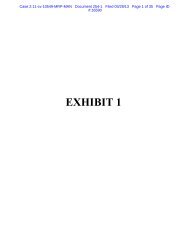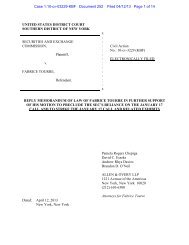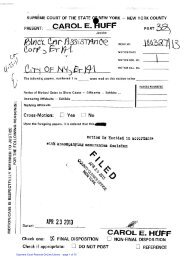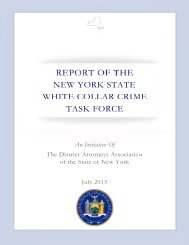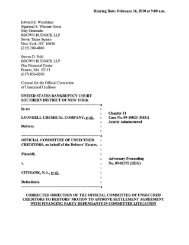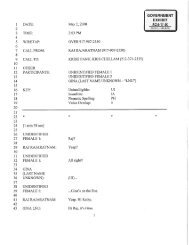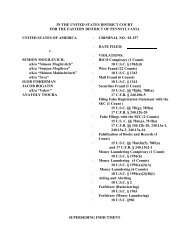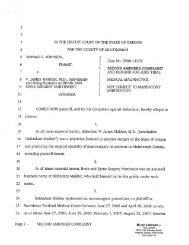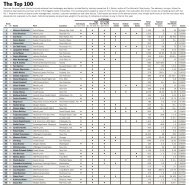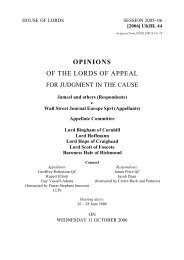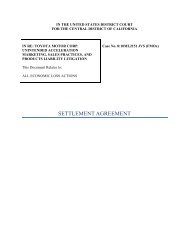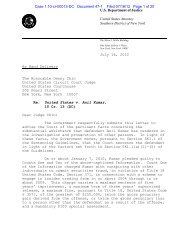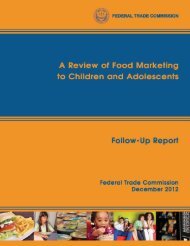Salz Review - Wall Street Journal
Salz Review - Wall Street Journal
Salz Review - Wall Street Journal
You also want an ePaper? Increase the reach of your titles
YUMPU automatically turns print PDFs into web optimized ePapers that Google loves.
<strong>Salz</strong> <strong>Review</strong><br />
An Independent <strong>Review</strong> of Barclays’ Business Practices<br />
50<br />
5.52 It is clear to us that Protium damaged Barclays’ reputation in the eyes of its<br />
regulators and the market. We consider that Protium serves as an illustration of:<br />
― The very significant financial pressures Barclays experienced during the<br />
financial crisis and its desire to reassure the market on its management of risk;<br />
― A complex transaction which Barclays believed complied with the rules but<br />
some stakeholders questioned as being inconsistent with their spirit;<br />
― Communication misunderstandings between Barclays and the FSA;<br />
― A mis-judgment by Barclays management and the Board as to the potential<br />
damage to the bank’s reputation in taking an approach which, as it turned out,<br />
tended to confirm sceptical attitudes to Barclays assets and their valuations;<br />
― The inclination to use unusual incentive arrangements to reward and secure<br />
important expertise.<br />
Models to Calculate Capital<br />
5.53 Banks can calculate the amount of capital they are required to hold under the Basel II<br />
rules by using either their own models or standardised approaches prescribed by local<br />
regulators (with any specific modification approved). 83 Since the models differ<br />
between banks and the regulatory approaches differ by country, it is recognised that<br />
there can be significant variations in the resulting risk asset weights. 84<br />
5.54 In a letter from Lord Turner to Marcus Agius on 10 April 2012, the FSA 85 wrote<br />
that, during the 2008 discussions on capital requirements, “Barclays was not fully<br />
transparent … about the RWA 86 impacts of a proposed extension of model<br />
approaches”. 87<br />
5.55 We understand that this relates to discussions between the FSA and Barclays,<br />
following the Lehman acquisition in 2008, concerning the approach to be used to<br />
calculate regulatory capital requirements for the US entity when producing Group<br />
consolidated capital requirements. At the time of the acquisition, regulations allowed<br />
UK banks to use local standardised approaches for assets in foreign entities for<br />
capital purposes. However, this changed in 2011 when, like regulators in other<br />
EU countries, the FSA began requiring banks to use its rules for these assets.<br />
5.56 Barclays’ interviewees told us that the FSA is continuing to review the systems and<br />
calculations Barclays uses in the standardised (non-modelled) approaches following<br />
the concerns expressed above about risk-weighted assets.<br />
5.57 We consider this to illustrate how stretched Barclays’ systems and operational<br />
processes were by the Lehman transaction, combined with business growth and<br />
changes in the regulatory environment. We are aware that it is common for banks to<br />
83 The standardised approaches are sometimes referred to as non-modelled approaches.<br />
84 See Appendix J.<br />
85 See Appendix K.<br />
86 A financial institution’s Risk-Weighted Assets (RWA) represent the base minimum amount of capital<br />
required; it is computed as a percentage of the financial institution’s assets, weighted by risk; see<br />
Appendix J.<br />
87 Treasury Select Committee, Fixing LIBOR: Some preliminary findings – Appendix, 9 August 2012.



